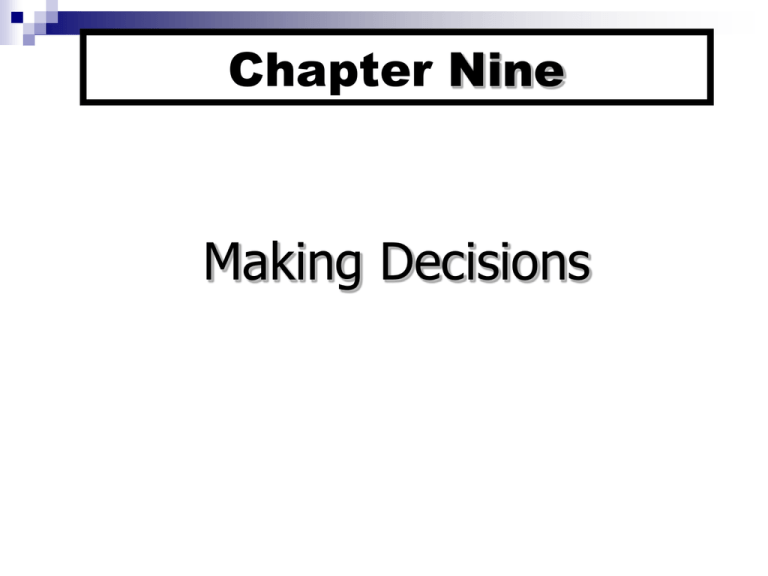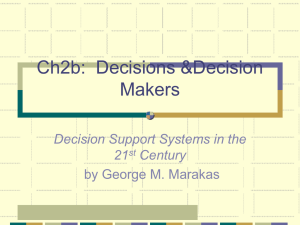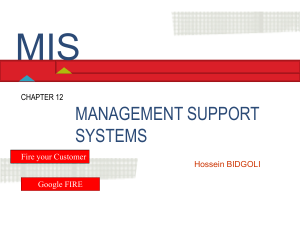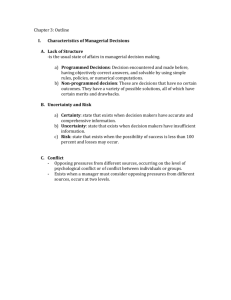BA 352 lecture ch9
advertisement

Chapter Nine Making Decisions Chapter Nine Outline Models of Decision Making •The Rational Model •Simon’s Normative Model Dynamics of Decision Making •Contingecny Model of Decision Making •Improving Decision Making •General Decision-Making Styles •Escalation of Commitment •Creativity Chapter Nine Outline (continued) Group Decision Making •Advantages and Disadvantages of Group-Aided Decision Making •Participative Management •When to Have Groups Participate in Decision Making: The Vroom/Yetton/Jago Model •Group Problem-Solving Techniques 9-2 The Rational Model of Decision Making •Consists of a structured four-step sequence * identifying the problem * generating alternative solutions * selecting a solution * implementing and evaluating the solution Simon’s Normative Model of Decision Making •Based on the notion of bounded rationality, i.e. decision makers face a variety of constraints •Decision making is characterized by * limited information processing * use of judgmental heuristics (rules, shortcuts) * satisficing Judgmental Heuristics Availability Heuristic: A decision maker’s tendency to base decisions on information that is readily available in memory. Representativeness Heuristic: The tendency to assess the likelihood of an event occurring based on one’s impressions about similar occurrences. Judgmental Heuristics (cont) Satisficing: Choosing a solution that meets a minimum standard of acceptance A Contingency Model for Selecting a Solution Characteristics of Decision Task: The decision problem * Unfamiliarity * Ambiguity * Complexity *Instability The decision environment *Irreversibility * Significance *Accountability * Time and/or money constraints Generating alternatives Characteristics of Decision Maker * Knowledge * Ability * Motivation * Risk Propensity * Decision Making Style Strategies to select a solution * Aided analytic * Unaided-analytic * Nonanalytic Contingency Relationships in Decision Making 1. Analytic Strategies are used when the decision problem is unfamiliar, ambiguous, complex, or unstable 2. Nonanalytic methods are employed when the problem is familiar, straightforward, or stable. 3. Assuming there are no monetary or time constraints, analytic approaches are used when the solution is irreversible and significant and when the decision maker is accountable. 4. Nonanalytic strategies are used when the decision can be reversed and is not very significant or when the decision maker is not held accountable. Contingency Relationships in Decision Making (cont) 5. As the probability of making a correct decision goes down, analytic strategies are used. 6. As the probability of making a correct decision goes up, nonanalytic strategies are employed. 7. Time and money constraints automatically exclude some strategies from being used. 8. Analytic strategies are more frequently used by experienced and educated decision makers. 9. Nonanalytic approaches are used when the decision maker lacks knowledge, ability, or motivation to make a good decision. Improving Decision Making Through Effective Knowledge Management Sytems and practices that increase the sharing of knowledge and information Types of knowledge Tacit knowledge – intuition, experience, natural abilities Explicit knowledge Explicit knowledge requires access to large amounts of information; tacit knowledge is obtained through observation, mentoring, collaboration, etc. General Decision Making Styles Based on how one perceives and comprehends stimuli and chooses to respond Value orientation – task and technical concerns or people and social concerns Tolerance for ambiguity – need of structure or control Decision Making Styles High Analytical Conceptual Directive Behavioral Low Tasks and Technical Concerns People and Social Concerns Value Orientation 9-8 Hands on Exercise What is Your Decision Making Style? • Which of the four styles best represents your decision-making style? Which is least reflective of your style? • How do your scores compare with the following norms: directive (75), analytical (90), conceptual (80), and behavioral (55)? • What are the advantages and disadvantages of your decision-making style? Escalation of Commitment Tendency to stick to a course of action even when it is associated with and unlikely to reverse a bad situation. Why? Psychological and social Bias facts to support a decision “Recover losses” more attractive than achieve gains Ego Organizational inertia Characteristics of project – long-term returns Contextual determinants – outside organization 9-9 Skills and Best Practices: Recommendations to Reduce Escalation of Commitment 1. Set minimum targets for performance, and have decision makers compare their performance with these targets. 2. Have different individuals make the initial and subsequent decisions about a project. 3. Encourage decision makers to become less egoinvolved with a project. 4. Provide more frequent feedback about project completion and costs. 5. Reduce the risk of penalties of failure. 6. Make decision makers aware of the costs of persistence. 9-10 Stages Underlying the Creative Process 1. Preparation: Reflects the notion that creativity starts from a base of knowledge. 2. Concentration: Where an individual concentrates on the problem at hand. 3. Incubation: Done unconsciously. During this stage, people engage in daily activities while their minds simultaneously mull over information and make remote associations. 4. Illumination: Remote associations from the incubation stage are ultimately generated. 5. Verification: Entails going through the entire process to verify, modify, or try out the new idea. Group decision-making Data suggests that innovative groups possessed high levels of both minority dissent and participation in decision making Note four requirements of effective decision making in a group – focus on process, e.g. requirements for an effective choice, assess positive and negative qualities of alternative solutions, which suggest openness, dissent? 9-11 Table 9-2 Advantages and Disadvantages of Group-Aided Decision Making Advantages 1. Greater pool of knowledge 2. Different perspectives 3. Greater comprehension 4. Increased acceptance 5. Training ground Disadvantages 1. Social pressure 2. Minority domination 3. Logrolling 4. Goal displacement 5. “Groupthink” Group Problem Solving Techniques Definition of consensus – . . . reached when all members can say they either agree . . . Or have had their “day in court” and were unable to convince the others of their viewpoint. In the final analysis, everyone agrees to support the outcome Group Problem Solving Techniques Other approaches to a group decision Unanimity A minority or one decides More Formal Group Problem Solving Techniques Brainstorming - disciplined process Silent idea (optional) Ideas/opinions solicited and written on a board, disallowing criticisms, allowing piggy-backing on ideas, clarification Delphi technique is another, more formal form of brainstorming. Involves several rounds of questionnaire, feedback, etc. Useful in cases where participants are not in the same place. More Formal Group Problem Solving Techniques Nominal Group Technique – used to narrow down options through voting Computer-aided Decision Making Uses computers to manage brainstorming or delphi questioning





